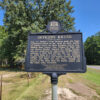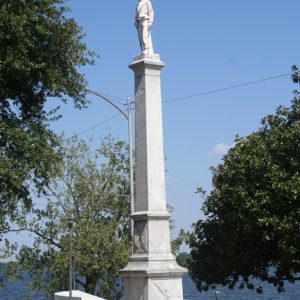calsfoundation@cals.org
Lake Village Confederate Monument
The Lake Village Confederate Monument is a commemorative sculpture erected in 1910 by the Jacob McConnell Chapter of the United Daughters of the Confederacy (UDC) of Lake Village (Chicot County) and the George K. Cracraft UDC Chapter from Eudora (Chicot County) in honor of local men who had served in the Confederate army during the Civil War.
Chicot County provided three companies for Confederate service during the Civil War. Among the soldiers who served in them were Captain Jacob McConnell, who fought with the Chicot Rangers (Company A, First Arkansas Mounted Rifles) and was killed in action in the fighting at Chickamauga, Georgia, on September 20, 1863, and Captain George K. Cracraft of Company G, Twenty-Third Arkansas Infantry, who was one of the “Immortal Six Hundred.” In the early twentieth century, their eponymously named United Daughters of the Confederacy chapters decided to honor them and other Chicot County soldiers who had fought in the Civil War.
The chapters acquired the monument in 1910, despite having raised only $856.20 of the $3,000 cost. County records of the Chicot County Quorum Court from 1910 show that the county also provided at least $500 toward the monument’s cost, paying off an advance from Chicot Bank and Trust Company in what was described as a “first installment.”
The monument is about twenty-six feet tall and features an Italian marble statue of a Confederate infantryman atop a Georgia granite shaft. The west side of the shaft is engraved “1861–1865 CSA / TO THE CONFEDERATE SOLDIERS OF CHICOT / COUNTY, THE RECORD OF WHOSE SUBLIME / SELF SACRIFICE AND UNDYING DEVOTION / IS THE PROUD HERITAGE / OF A LOYAL POSTERITY.” The east side is inscribed “ERECTED BY THE / CAPTAIN MCCONNELL / AND / GEORGE K. CRACRAFT / CHAPTERS, U.D.C. / A.D. 1910 / AND CHICOT COUNTY / DEAR, IN LIFELESS CLAY / WHETHER UNKNOWN TO FAME / THEIR CAUSE AND COUNTRY STILL THE SAME / THEY DIED AND WORE THE GREY. / FATHER RYAN.”
The Lake Village Confederate Monument was dedicated on October 26, 1910, and a local newspaper reported that “it was a gala day, large crowds assembled from all parts of the county to witness the dedication of the beautiful monument.” The ceremony included “songs and drills” by students of the Lakeside Hill and Catholic schools and a string band from Greenville, Mississippi. The paper reported, “At the moment the cords were pulled by five little girls, being lineal descendants and representing five of the Chicot county officers who won undying fame on the fields of battle, a salute of heavy artillery proclaiming the fact, echoed and re-echoed far and across the deep and placid waters of beautiful Lake Chicot.” The monument was “surrounded at its base by an elaborate fountain, furnished with constantly flowing water, springing from the mouths of two miniature cannon.”
The Lake Village Confederate Monument, originally closer to an earlier Chicot County Courthouse, now stands in the middle of Lakeshore Drive near the present courthouse, a move that likely accounts for chips on the monument’s base and the loss of one of the cannons.
The Lake Village Confederate Monument was listed on the National Register of Historic Places on May 3, 1996.
For additional information:
“The Chicot Rangers.” http://www.couchgenweb.com/civilwar/chicrang.html (accessed May 26, 2018).
“Confederate Monument Unveiled.” Dermott News, November 4, 1910.
Dodson, Mrs. Thomas F. “Confederate Monuments and Markers in Arkansas.” Arkansas Division UDC, 1960.
Logan, Charles Russell. “Something So Dim It Must Be Holy”: Civil War Commemorative Sculpture in Arkansas, 1886–1934. Little Rock: Arkansas Historic Preservation Program, 1996. Online at https://www.arkansasheritage.com/arkansas-preservation/programs/publications (accessed April 18, 2024).
Simons, Don R. In Their Words: A Chronology of the Civil War in Chicot County, Arkansas, and Adjacent Waters of the Mississippi River. Sulphur, LA: Wise Publications, 2000.
Slater, John. “Lake Village Confederate Monument.” National Register of Historic Places registration form. On file at Arkansas Historic Preservation Program, Little Rock, Arkansas. Online at https://www.arkansasheritage.com/arkansas-historic-preservation-program (accessed April 18, 2024).
Mark K. Christ
Arkansas Historic Preservation Program
 Civil War Markers and Memorials
Civil War Markers and Memorials Early Twentieth Century, 1901 through 1940
Early Twentieth Century, 1901 through 1940 Historic Preservation
Historic Preservation Lake Village Confederate Soldiers Monument
Lake Village Confederate Soldiers Monument 




Comments
No comments on this entry yet.